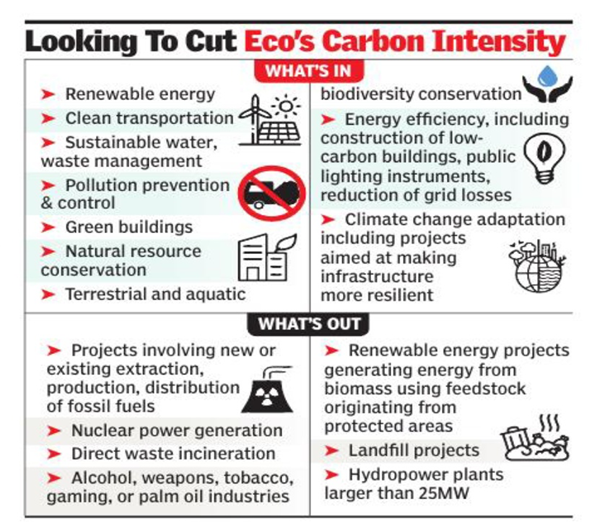Context
-
The Union Minister for Finance & Corporate Affairs recently approves the final Sovereign Green Bonds framework of India.
About the Sovereign Green Bonds framework
- This approval will further strengthen India’s commitment towards its Nationally Determined Contribution (NDCs) targets, adopted under the Paris Agreement, and help in attracting global and domestic investments in eligible green projects.
- The proceeds generated from issuance of such bonds will be deployed in Public Sector projects which help in reducing carbon intensity of the economy.
- The Framework comes close on the footsteps of India’s commitments under “Panchamrit” as elucidated by the Prime Minister at COP26 at Glasgow in November, 2021.
- The approval is fulfillment of the announcement in the Union Budget FY 2022-23 by the Union Finance Minister that Sovereign Green Bonds will be issued for mobilising resources for green projects.
- Green bonds are financial instruments that generate proceeds for investment in environmentally sustainable and climate-suitable projects.
- By virtue of their indication towards environmental sustainability, green bonds command a relatively lower cost of capital vis-à-vis regular bonds and necessitates credibility and commitments associated with the process of raising bonds.
- In the above context, India’s first Sovereign Green Bonds framework was formulated and as per the provisions of the framework, Green Finance Working Committee (GFWC) was constituted to validate key decisions on issuance of Sovereign Green Bonds.
The Sovereign Green Bond Framework lists the following green projects as falling under the eligible category. The eligible expenditure is limited to government expenditure that occurs a maximum 12 months prior to the issuance of green bonds.
| Green project category | Environmental objective | Eligibility criteria |
| Renewable energy | Climate change mitigation
Net zero objectives |
|
| Energy efficiency | Climate change mitigation
|
|
| Clean transportation | Climate change mitigation
|
|
| Climate change adaptation | Climate change
adaptation |
|
| Sustainable water and waste
management |
Climate change mitigation
|
|
| Pollution prevention and
control |
Climate change mitigation
Environment protection |
|
| Green buildings | Climate change mitigation |
|
| Sustainable management of
living natural resources and land use |
Natural resource conservation |
|
| Terrestrial and aquatic
biodiversity conservation |
Biodiversity conservation |
|
Which projects are excluded from this list?
- Projects involving new or existing extraction, production and distribution of fossil fuels, including improvements and upgrades; or where the core energy source is fossil-fuel based
- Nuclear power generation
- Direct waste incineration
- Alcohol, weapons, tobacco, gaming, or palm oil industries
- Renewable energy projects generating energy from biomass using feedstock originating from protected areas
- Landfill projects
- Hydropower plants larger than 25 MW
- Expenditures directly related to fossil fuel
Project evaluation and selection
- For the purpose of project selection and evaluation, the government has constituted a Green Finance Working Committee (GFWC), which will meet at least twice a year to support the Ministry of Finance with selection and evaluation of projects and other relevant work related to the Framework.
Management of proceeds
- The proceeds will be deposited to the Consolidated Fund of India (CFI), and then funds from the CFI will be made available for eligible green projects.
- The Public Debt Management Cell (PDMC) will keep a track of proceeds within the existing guidelines regarding debt management and monitor the allocation of funds towards eligible green expenditures. Unallocated proceeds, if any, will be carried forward to successive years for investment in eligible green projects only.
- The government will ensure that all proceeds are allocated within a span of two years from the date of issuance.
Back to Basics
What are green bonds?
- The Green Bond Principles (Voluntary Guidelines for Issuing Green Bonds) by the International Capital Markets Association (ICMA) define a green bond as any type of instrument where the proceeds or an equivalent amount will be exclusively applied to finance or re-finance, in part or in full, new and/or existing eligible green projects.
- As per these principles, green bonds may include:
- Standard green bonds: A recourse-to-the-issuer based debt obligation.
- Green revenue bonds: A non-recourse-to-the issuer-based debt obligation. Here, credit risk exposure under the instrument is pledged to the project revenue flows.
- Green project bond: A recourse/non-recourse-to-the issuer debt obligation. Here, the borrower has direct risk exposure for green project(s).
- Green securitised bond: A bond backed by green project(s), with the primary repayment source being the project revenue flows.
- The only significant difference between green bonds and ordinary bonds is that the funds raised from investors are only used to support environmentally sustainable initiatives, such as green construction, renewable energy, etc.
Reference: PIB & India Briefing
Visit Abhiyan PEDIA (One of the Most Followed / Recommended) for UPSC Revisions: Click Here
IAS Abhiyan is now on Telegram: Click on the Below link to Join our Channels to stay Updated
IAS Abhiyan Official: Click Here to Join
For UPSC Mains Value Edition (Facts, Quotes, Best Practices, Case Studies): Click Here to Join

